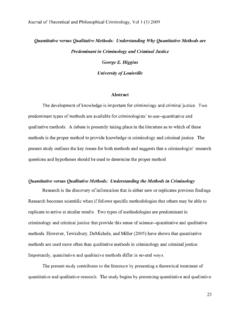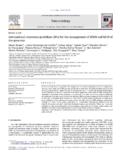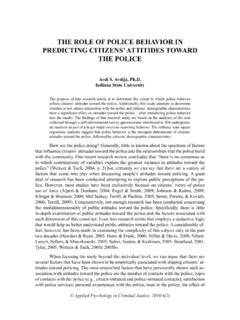Transcription of February 1, 2011 Unauthorized ... - Pew Research …
1 February 1, 2011 Unauthorized Immigrant Population: National and State Trends, 2010 FOR FURTHER INFORMATION CONTACT: Jeffrey S. Passel, Senior Demographer D Vera Cohn, Senior Writer 1615 L St, , Suite 700 Washington, 20036 Tel (202) 419-3600 Fax (202) 419-3608 Copyright 2011 1 Unauthorized Immigrant Population: National and State Trends, 2010 * * * * As of March 2010, million Unauthorized immigrants were living in the United States, virtually unchanged from a year earlier, according to new estimates from the Pew Hispanic Center, a project of the Pew Research Center. This stability in 2010 follows a two-year decline from the peak of 12 million in 2007 to million in 2009 that was the first significant reversal in a two-decade pattern of growth. The number of Unauthorized immigrants in the nation s workforce, 8 million in March 2010, also did not differ from the Pew Hispanic Center estimate for 2009.
2 As with the population total, the number of Unauthorized immigrants in the labor force had decreased in 2009, from its peak of million in 2007. The number of children born to at least one Unauthorized -immigrant parent in 2009 was 350,000, essentially the same as it was a year earlier. An analysis of the year of entry of Unauthorized immigrant parents of babies born in 2009 indicates that 61% arrived before 2004, 30% arrived from 2004 to 2007, and 9% arrived from 2008 to 2010. According to the Pew Hispanic Center, Unauthorized immigrants made up of the nation s population and of its labor force in March 2010. Births to Unauthorized immigrant parents accounted for 8% of newborns from March 2009 to March 2010, according to the center s estimates, which are based mainly on data from the government s Current Population Survey. Figure 1 Estimates of the Unauthorized Immigrant Population, 2000-2010 (millions) Notes: Bars indicate low and high points of the estimated 90% confidence interval.
3 The symbol * indicates the change from the previous year is statistically significant. Source: Pew Hispanic Center estimates based on residual methodology applied to March Supplements to the Current Population Survey. See Methodology. PEW Research CENTER 2 Unauthorized Immigrant Population: National and State Trends, 2010 The decline in the population of Unauthorized immigrants from its peak in 2007 appears due mainly to a decrease in the number from Mexico, which went down to million in 2010 from 7 million in 2007. Mexicans remain the largest group of Unauthorized immigrants, accounting for 58% of the total. The decline in the population of Unauthorized immigrants since 2007 has been especially marked in some states that recently had attracted large numbers of Unauthorized immigrants. The number has decreased in Colorado, Florida, New York and Virginia.
4 The combined Unauthorized immigrant population of three contiguous Mountain West states Arizona, Nevada and Utah also declined. The number of Unauthorized immigrants may have declined in other states as well, but this cannot be stated conclusively because the measured change was within the margin of error for these estimates. In contrast to the national trend, the number of Unauthorized immigrants has grown in some West South Central states. From 2007 to 2010, there was a statistically significant increase in the combined Unauthorized immigrant population of Louisiana, Oklahoma and Texas. The change was not statistically significant for these states individually, but it was for the combined three states. Texas has the second largest number of Unauthorized immigrants, trailing only California. Despite the recent decline and leveling off, the number of Unauthorized immigrants living in the United States has tripled since 1990, when it was million.
5 The size of this population grew by a third since 2000, when was million. The estimates are produced using a multistage method that subtracts the legal foreign-born population from the total adjusted foreign-born population, with the residual then used as the source of information about Unauthorized immigrants. The source of these data is the Census Bureau s March Current Population Surveys. Table 1 States with Changes in Unauthorized Immigrant Populations, 2007-2010 (thousands) 2010 2007 Change Decline Florida 825 1,050 -230 New York 625 825 -200 Virginia 210 325 -100 Colorado 180 240 -65 AZ-UT-NV 700 850 -160 Increase TX-LA-OK 1,800 1,550 +240 Note: Changes shown are statistically significant based on 90% confidence interval, and are the only statistically significant changes for 2007 to 2010 for individual states. Unauthorized estimates are rounded.
6 Change is computed from unrounded data and independently rounded. Source: Pew Hispanic Center estimates based on augmented March Supplements to the Current Population Survey. See Methodology. PEW Research CENTER 3 Unauthorized Immigrant Population: National and State Trends, 2010 Because these estimates are derived from sample surveys, they are subject to uncertainty from sampling error, as well as other types of error. Each annual estimate of the Unauthorized population is actually the middle point of a range of possible values that could be the true number. Additionally, the change from one year to the next has its own margin of error. Because of the margin of error in these estimates, two numbers may look different but cannot be said definitively to be different. For example, there is no statistically significant difference between the estimate of the Unauthorized population for 2009 ( million) and the estimate for 2010 ( million).
7 Similarly, some state estimates for single years are based on small samples; especially in less populous states, two single years should not be compared. These ranges represent 90% confidence intervals, meaning that there is a 90% probability that the range contains the true value. Although the estimates presented here indicate trends in the size and composition of the Unauthorized -immigrant population, they are not designed to answer the question of why these changes occurred. There are many possible factors. The deep recession that began in the economy in late 2007 officially ended in 2009, but recovery has been slow to take hold and unemployment remains high. Immigration flows have tended to decrease in previous periods of economic distress. The period covered by this analysis also has been accompanied by changes in the level of immigration enforcement and in enforcement strategies, not only by the federal government but also at state and local levels.
8 Immigration also is subject to pressure by demographic and economic conditions in sending countries. This analysis does not attempt to quantify the relative impact of these forces on levels of Unauthorized immigration. 4 Unauthorized Immigrant Population: National and State Trends, 2010 About this Report This report estimates the size of the Unauthorized immigrant population, as well as the Unauthorized immigrant labor force for the nation and each state in March 2010. For the nation, it also describes this population by region or country of birth and arrival period. For some of these variables, the report provides annual trends from 2000 onward. Updating and expanding on an earlier report about children of Unauthorized immigrants, the report provides estimates and trends for the status of children of Unauthorized immigrants as well as information about their parents period of arrival and country of origin.
9 The Pew Hispanic Center estimates the Unauthorized immigrant population using the residual method, a well-developed and widely accepted technique that is based on official government data. Under this methodology, a demographic estimate of the legal foreign-born population naturalized citizens, legal permanent residents, temporary legal residents and refugees is subtracted from the total foreign-born population. The remainder, or residual, is the source of population estimates and characteristics of Unauthorized immigrants. These Pew Hispanic Center estimates use data mainly from the Current Population Survey (CPS), a monthly survey of about 55,000 households conducted jointly by the Bureau of Labor Statistics and the Census Bureau. It is best known as the source for monthly unemployment statistics. Each March, the CPS sample size and questionnaire are expanded to produce additional data on the foreign-born population and other topics.
10 The Pew Hispanic Center estimates make adjustments to the government data to compensate for undercounting of some groups, and therefore its population totals differ somewhat from the ones the government uses. Estimates for any given year are based on a March reference date. Because of small sample size in many states and potentially large sampling variability, some state estimates presented are based on multiyear averages. For the 34 states with fewer than 50 cases of Unauthorized immigrant households in the 2010 sample survey, the estimates for that year are an average of 2009 and 2010. These states are Alabama, Alaska, Arkansas, Delaware, Hawaii, Idaho, Indiana, Iowa, Kansas, Kentucky, Louisiana, Maine, Massachusetts, Michigan, Minnesota, Mississippi, Missouri, Montana, Nebraska, New Hampshire, New Mexico, North Dakota, Ohio, Oklahoma, Pennsylvania, Rhode Island, South Carolina, South Dakota, Tennessee, Utah, Vermont, West Virginia, Wisconsin and Wyoming.





